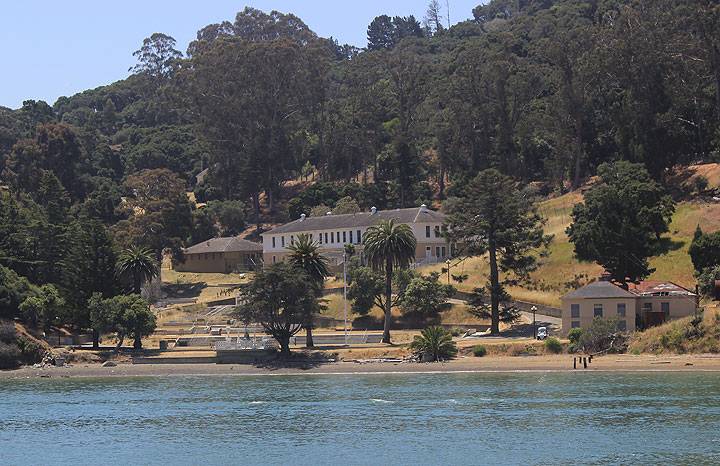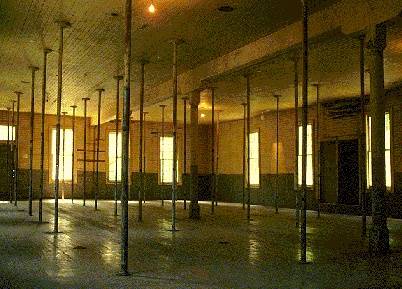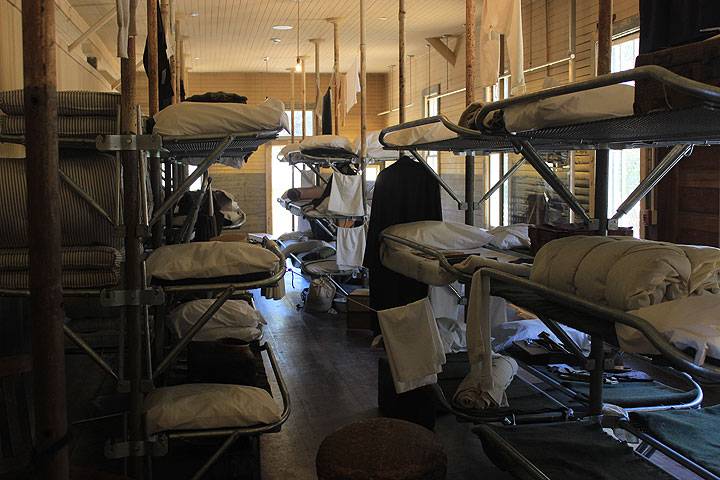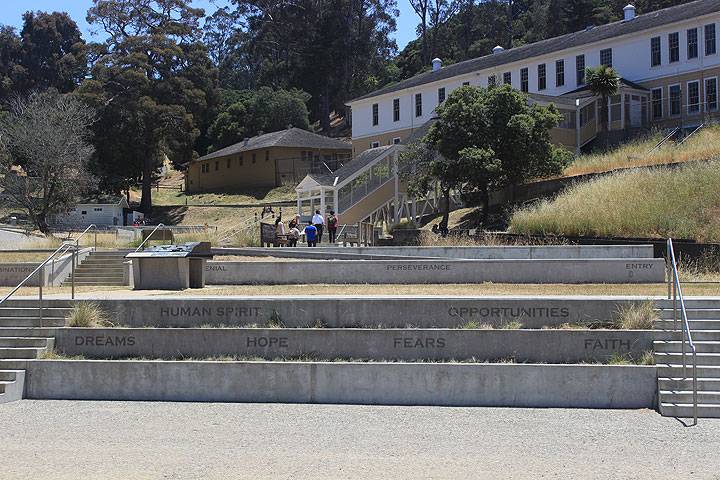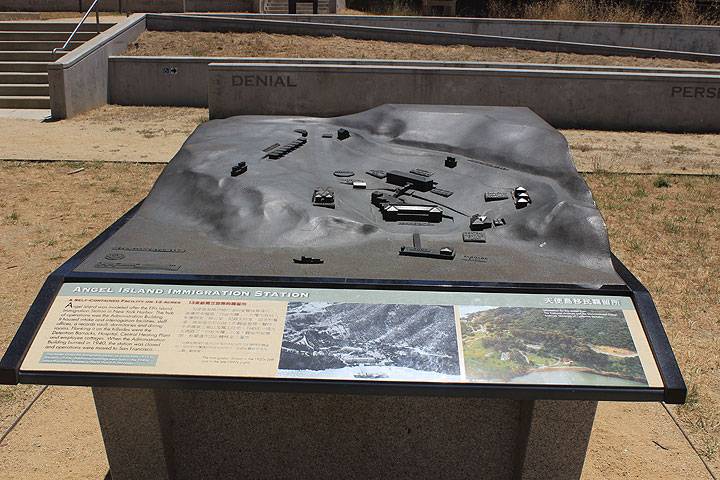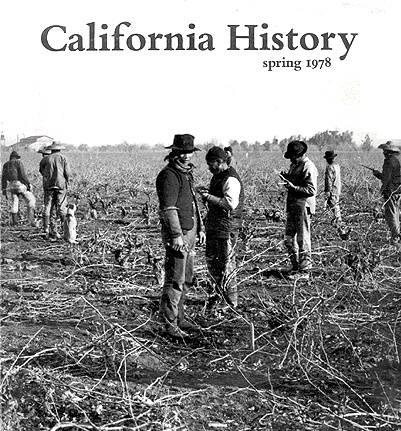Island of Immortals: Chinese Immigrants and the Angel Island Immigration Station
Historical Essay
by H.M. Lai
Angel Island Immigration Station, the original structures are now a public museum, 2014.
Photo: Chris Carlsson
The Federal Sundry Civil Appropriation Act of March 3, 1905, included $200,000 for erection of the Angel Island Immigration Station, and Walter J. Mathews was selected as architect for the facility. Work begun at the North Garrison (Winslow Cove) area of the island was interrupted by the San Francisco Earthquake in 1906, and the facility was completed in October of 1908. The complex included an administration building, power house, hospital, and detention building, with a wharf and dock storehouse at the beach below.[12]
The Angel Island station officially opened on January 21, 1910. The next morning at 9:00 A.M., 101 People from the S.S. Siberia (including 84 Chinese men, 1 Chinese woman, 3 Japanese, and 4 East Indians) who had not been allowed to debark in San Francisco were removed from Pacific Mail Company's wharf and transferred to the island. The Chinese immigrants on the S.S. China followed, and by the end of the day, over 400 passengers, mostly Chinese, had been moved to the insular facility without incident.[16]
The opening of the facility moved the influential Chinatown newspaper Chinese World to reflect on past treatment of the community and to anticipate its future reception. On January 22, 1910, it editorialized:
"Ever since the establishment of this wooden shed at the wharf, the mistreatment of us Chinese confined there was worse than for jailed prisoners. The walls were covered with poems [expressing feelings about being incarcerated]; traces of tears soaked the floor. There were even some who could not endure the cruel abuse and took their own lives. The ropes they used to hang themselves are still visible. Those seeing this cannot help but feel aggrieved and gnash their teeth in anger. Now the Chinese had been moved from this wooden shed. From now on we will be confined on a barren offshore island."
Men's Dormitory at abandoned Immigration Station at Angel Island, 1990s.
Photo: Chris Carlsson
Re-creation of the immigration barracks, Angel Island Immigration Station museum, 2014.
Photo: Chris Carlsson
During the first decade of the facility's existence, major internal problems troubled its administration. A few months after its opening, the immigration commissioner supervising the station, Hart North, was suspended from his post. One of the charges leveled against him was that he was partial to Japanese and Hindu immigration.[20]
In 1917 a major scandal developed when a graft ring was discovered to be stealing and manipulating Chinese records at the station in connection with illegal entries. Eighteen people were indicted (including eight from the Immigration Service), and seven were found guilty. As well, the San Francisco law firm of Stidger and Kennah, which handled numerous Chinese cases, was banned from practicing at the Bureau of Immigration.[21] Subsequently, no large scandals reached the station, although from time to time the occasional dismissal of interpreters and other employees indicated that petty graft was by no means completely eradicated.
It also did not take long for the government to tacitly agree with the Chinese that the insular location of the station was unsatisfactory, although they came to the conclusion for different reasons. A few months after the facility's opening, acting commissioner Luther Steward submitted reports highly critical of the many physical and sanitary drawbacks in the facility's design. As early as 1913 the visiting secretary of labor observed that Angel Island was located too far from San Francisco to be convenient as an immigration station, suggesting that Fort Mason or Alcatraz Island might be better sites. In 1920 Immigration Commissioner Edward White declared that the facility's structures were like tinder, and he proposed removing the station to the mainland to cut expenses. By 1922 both Assistant Secretary of Labor Edward J. Henning and Commissioner General of Immigration W. W. Husband were in agreement with this idea. The latter declared moreover that the island facilities were filthy and unfit for habitation:
"The plant has practically nothing to commend it. It is made of a conglomeration of ramshackle buildings which are nothing but firetraps. They are illy arranged, and inconvenient. The sanitary arrangements are awful. If a private individual had such an establishment he would be arrested by the local health authorities. The whole place is . . . not worth spending any money on.[22]
In subsequent years the same questions were raised time and again,[23] but while bureaucrats debated, tens of thousands of Chinese immigrants continued to pass through these facilities over the next two decades. It was not until 1940 that the government finally abandoned the immigration station, and the exodus was hastened by a fire which destroyed the station's administration building on August 12 of that year. On November 5, Angel Island's last group of about 200 aliens, including 125 Chinese men and 19 Chinese women, was transferred to temporary quarters at 801 Silver Avenue in San Francisco.[24]
The National Park Service has done a great job of restoring the facilities and opening them to the public with excellent interpretative signs, exhibitions, and more.
Photo: Chris Carlsson
This final move prompted little opposition, for although discrimination against the Chinese were still common, the issue of Chinese immigration no longer inflamed people's passions in the same way. Exclusion laws had throttled the flow of Chinese to a small stream, and the Chinese in California had dropped from 8.7 percent of the total population in 1880 to less than 0.6 percent in 1940. Most Chinese had been relegated to occupations non-competitive with white Americans, and segregated in Chinatown ghettoes. Thus the Chinese were tolerated, if not accepted by many. In the intervening years, too, the focus of racist attacks had shifted to the Japanese. Moreover, by 1940, people's attentions were taken by the more immediate and pressing issue of impending world war.
After the closing of the immigration station, in an attempt to meet the political demands of the "war for democracy," Congress repealed the exclusion acts of 1943 and assigned an annual token immigration quota of 105 to the Chinese arrivals. However, they were still detained to determine the validity of their applications for admission. As for their detention quarters, after being relocated to Sharp Park in the spring of 1942, they were moved in 1944 into the Appraiser's Building at 630 Sansome Street near San Francisco's waterfront.[25] The practice of detaining Chinese to determine their eligibility for admission was finally discontinued in 1952 when consular officials at the port of embarkation assumed that responsibility.
from California History, spring 1978
Footnotes
12. Section III, "Historical American Building Survey," in Recommendations for the Historical Recreational Development of Angel Island, prepared by Marshall McDonald and Associates for the Division of Beaches and Parks, State of California (1966); U.S. Congress, House, Report No. 4640, Immigration Station on Angel Island, Cal., 59 Congress, I Session, 1906; San Francisco Chronicle, August 18, 1907.
13. Report of the Commissioner-General of Immigration, 1908/1909, p. 104
14. File No. 52961-26B, Record Set 85, National Archives, Washington, D.C.; Chung Sai Yat Po, Nov. 12, 1909.
15. Chung Sai Yat Po, Nov. 30, 1909.
16. Chinese World, Jan. 22, 1910 San Francisco Chronicle, Jan. 23, 1910.
17. Chinese World, April 5, 1910. The CCBA, also known as the Chinese Six Companies, was at the time considered the spokesman for the Chinese community in America.
18. Report of the Commissioner-General of Immigration, 1909/1910, p. 133
19. Chinese World, May 2, June 9, March 1, 1910.
20. San Francisco Chronicle, Oct. 28, 1910.
21. U.S. Congress, House, Document No. 209, Report on House Resolution 225.
22. Luther C. Steward, Acting Commissioner, San Francisco, to commissioner general, Dec. 19, 1910, Record Set 85, National Archives; Chinese World, Nov. 17, 1913; San Frarrisco Chronicle, Aug. 8, 1920, March 14, 1922, Nov. 1, 1922.
23. For example, see San Francisco Chronicle, Dec. 12, 1923; Feb. 27, 1924; Oct. 10, 1927 Nov. 23, 1934; Feb. 24, 1937; Mar. 29, 1937.
24· Chung Sai Yat Po, Aug. 12, Nov. 7, 1940.
25. Handwritten manuscript on Angel Island Immigrant Station stationery, n.d., anonymous.
26. Information on the life of Chinese immigrants in the detention quarters was pieced together from interviews with thirty-five people who were on the island, including two interpreters, two inspectors, and a kitchen helper as well as male and female detainees whose experience spanned the entire period the immigration station was active.

